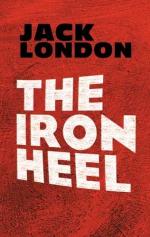* These Fighting groups were modelled somewhat after the Fighting Organization of the Russian Revolution, and, despite the unceasing efforts of the Iron Heel, these groups persisted throughout the three centuries of its existence. Composed of men and women actuated by lofty purpose and unafraid to die, the Fighting Groups exercised tremendous influence and tempered the savage brutality of the rulers. Not alone was their work confined to unseen warfare with the secret agents of the Oligarchy. The oligarchs themselves were compelled to listen to the decrees of the Groups, and often, when they disobeyed, were punished by death—and likewise with the subordinates of the oligarchs, with the officers of the army and the leaders of the labor castes.
Stern justice was meted out by these organized avengers, but most remarkable was their passionless and judicial procedure. There were no snap judgments. When a man was captured he was given fair trial and opportunity for defence. Of necessity, many men were tried and condemned by proxy, as in the case of General Lampton. This occurred in 2138 A.D. Possibly the most bloodthirsty and malignant of all the mercenaries that ever served the Iron Heel, he was informed by the Fighting Groups that they had tried him, found him guilty, and condemned him to death—and this, after three warnings for him to cease from his ferocious treatment of the proletariat. After his condemnation he surrounded himself with a myriad protective devices. Years passed, and in vain the Fighting Groups strove to execute their decree. Comrade after comrade, men and women, failed in their attempts, and were cruelly executed by the Oligarchy. It was the case of General Lampton that revived crucifixion as a legal method of execution. But in the end the condemned man found his executioner in the form of a slender girl of seventeen, Madeline Provence, who, to accomplish her purpose, served two years in his palace as a seamstress to the household. She died in solitary confinement after horrible and prolonged torture; but to-day she stands in imperishable bronze in the Pantheon of Brotherhood in the wonder city of Serles.
We, who by personal experience know nothing of bloodshed, must not judge harshly the heroes of the Fighting Groups. They gave up their lives for humanity, no sacrifice was too great for them to accomplish, while inexorable necessity compelled them to bloody expression in an age of blood. The Fighting Groups constituted the one thorn in the side of the Iron Heel that the Iron Heel could never remove. Everhard was the father of this curious army, and its accomplishments and successful persistence for three hundred years bear witness to the wisdom with which he organized and the solid foundation he laid for the succeeding generations to build upon. In some respects, despite his great economic and sociological contributions, and his work as a general leader in the Revolution,




